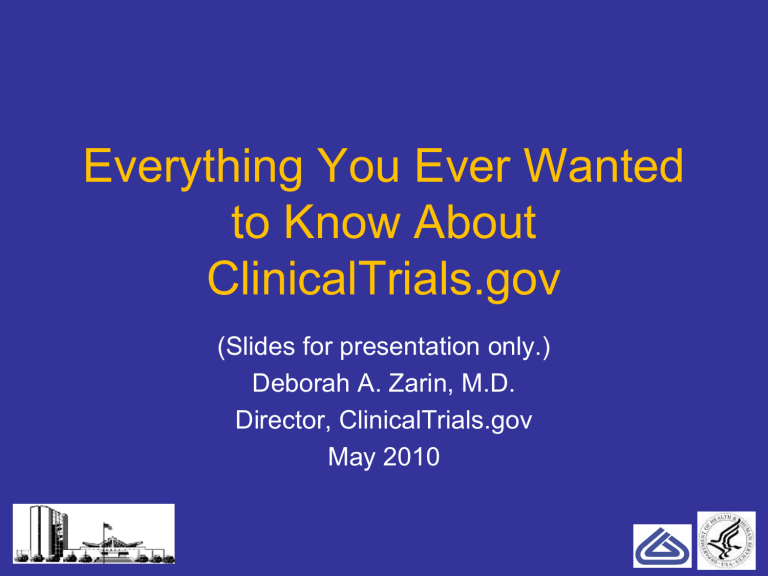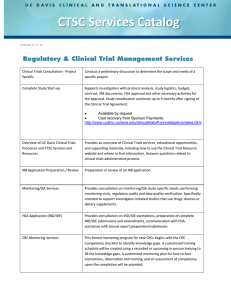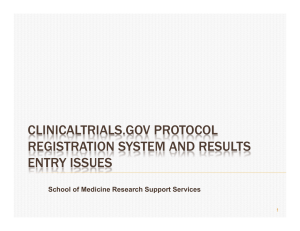
Everything You Ever Wanted to Know About ClinicalTrials.gov (Slides for presentation only.) Deborah A. Zarin, M.D. Director, ClinicalTrials.gov May 2010 1 Background 2 What’s All The Fuss About? • Suppression of research results impedes the scientific process • Suppression of clinical trial data is particularly problematic: – Trials depend on human volunteers; – Trial results inform our medical decisions 3 Screen shot of Washington Post article. A Silenced Drug Study Creates An Uproar. By Shankar Vedantam Wednesday, March 18, 2009 • “The results of Study 15 were never published or shared with doctors, even as less rigorous studies that came up with positive results for Seroquel were published and used in marketing campaigns aimed at physicians and in television ads aimed at consumers.” • “The results of Study 15 were provided only to the Food and Drug Administration -- and the agency has strenuously maintained that it does not have the authority to place such studies in the public domain.” Screen shot of : Lilly Sold Drug for Dementia Knowing It Didn’t Help, Files Show By Margaret Cronin Fisk, Elizabeth Lopatto and Jef Feeley “Eli Lilly & Co. urged doctors to prescribe Zyprexa for elderly patients with dementia, an unapproved use for the antipsychotic... after [it] sent study results to the U.S. Food and Drug Administration” showing Zyprexa didn’t alleviate dementia symptoms in older patients…” Screen shot of : The New England Journal of Medicine Outcome Reporting in Industry-Sponsored Trials of Gabapentin for Off-Label Use S. Swaroop Vedula, M.D., M.P.H., Lisa Bero, Ph.D., Roberta W. Scherer, Ph.D., and Kay Dickersin, Ph.D. N Eng J Med. 2009 Nov 12;361:1963-71 Reasons to Register Clinical Trials and Report Results • Human Subject Protections – Allows potential participants to find studies – Assists ethical review boards and others to determine appropriateness of studies being reviewed (e.g., harms, benefits, redundancy) – Promote fulfillment of ethical responsibility to human volunteers – research contributes to medical knowledge • Research Integrity – Facilitates tracking of protocol changes – Increases transparency of research enterprise • Evidence Based Medicine – Facilitates tracking of studies and outcome measures – Allows for more complete identification of relevant studies • Allocation of Resources – Promotes more efficient allocation of resources 7 Levels of “Transparency” 8 Zarin DA, Tse T.. Science. 2008 Mar 7;319(5868):1340-2. 10th Anniversary of ClinicalTrials.gov 2000 - 2010 9 History of ClinicalTrials.gov • FDAMA 113 (1997): Mandates Registry – IND trials for serious and life-threatening diseases • ClinicalTrials.gov Launched in February 2000 • ClinicalTrials.gov Accommodates Other Policies – Registration • Int’l Committee of Medical Journal Editors (ICMJE) • World Health Organization (WHO) – Registration and Results Reporting • Maine State Law; State Attorneys General • European Medicines Agency (EMA) • FDAAA 801 (2007): Expands Registry and Adds Results Database 10 FDAAA Sec.801 Expanded Clinical Trial Registry • Enacted on September 27, 2007 • Requires Trial Registration (Dec 2007) – Phase II-IV drug and device trials for all diseases – Data elements: ClinicalTrials.gov + ~ WHO/ICMJE • Requires Results Reporting (Sept 2008) – Trials of FDA-approved or cleared drugs and devices – “Basic” Results: Baseline Characteristics, Primary & Secondary Outcomes, Statistical Analyses – Adverse Events (Sept 2009) – “Expansion” of results by rulemaking (Sept 2010) • Added enforcement provisions 11 Trial Reporting: The Bottom Line Based on All Policies • Register all interventional studies prior to enrollment of the first participant • Keep entries up to date • Report results for trials subject to FDAAA: – Drugs, devices, biologics – Not Phase 1 – One year after “primary completion date” (unless special circumstances apply) 12 ClinicalTrials.gov—the Basics 13 ClinicalTrials.gov Statistics (as of 5/24/2010) Number Total Type of Trial Observational Interventional – Drug & Biologic – Behavioral, Gene Transfer, Other – Surgical Procedure – Device* International Sites (172 countries) US only Non-US only US & Non-US mixed Missing Percent 90,137 100% 15,252 74,107 53,628 17% 83% 15,373 9,227 5,538 41,513 33,414 5,823 9,387 46% 37% 6% 10% 14 *287 applicable device clinical trials submitted, but qualify for “delayed posting” under FDAAA 15 ClinicalTrials.gov Statistics (cont.) (as of 5/24/10) Number Percent 10,828 29,233 50,076 90,137 12% 32% 55% Trials by Sponsor US Federal (including NIH) Industry University, Other Total User Statistics Page Views per month Unique visitors per month 70 Million 950,000 16 ClinicalTrials.gov Visitors by “Role” Screen shot of : Map of the World indicating number of studies with locations in that region. (N=13,097) Patient - Volunteer Researcher Family/Friend Patient - Learn Provider Other Trial Team Personnel Student/Educator Healthy Volunteer Investor Journalist Healthcare Admin Advocate 23% 14% 13% 12% 10% 9% 7% 4% 3% 2% 1% 1% 1% Source: American Customer Satisfaction Index (ASCI) Online Consumer Survey; Six-Month Period in 2007 Sample Registry Record 18 Screen shot of ClinicalTrials.gov showing Full Text View 19 Screen shot of ClinicalTrials.gov showing Tabular View 20 Screen shot of ClinicalTrials.gov showing archive 21 Screen shot of MedlinePlus 22 Screen shot of ClinicalTrials.gov number in The New England Journal of Medicine 23 Screen shot of NLM Technical Bulletin article 24 Screen shot of journal citation in PubMed highlighting Secondary Source ID 25 Screen shot highlighting U.S. FDA Resources 26 Screen shot highlighting Clinical Trials in U.S. FDA 510 (k) Premarket Notification 27 Basic Results Database Basic Results Database 28 Basic Results Reporting Requirements • Results of FDA-approved/cleared products • Generally, submission within 12 months of the earlier of estimated/actual primary completion date • Delayed Submission of Results – Seeking initial approval – Seeking approval of a new use – Extensions for “good cause” 29 Basic Results Modules • • • • • Participant Flow Baseline and Demographic Characteristics Outcome Measures Adverse Events (summary data) Other Information – “Certain Agreements” Restricting Results Disclosure – Overall Limitations and Caveats – Results Point of Contact 30 Sample Posted Results 31 Screen shot of Clinical Trials Study Results 32 Arms Screen shot of Participant Flow: Overall Study Milestone Reasons Not Completed 33 Screen shot of Baseline Characteristics “Default” Required Measures User-Specified Measure Categories 34 Screen shot of Outcome Measures 35 Screen shot of Primary Outcomes Measure 36 Screen shot of Measures Values and Statistical Analysis Statistical Analysis 37 Screen shot of Serious Adverse Effects 38 ICJME “…will not consider results posted in the same primary clinical trials register in which the initial registration resides as previous publication if the results are presented in the form of a brief, structured (<500 words) abstract or table.” [NOTE: Only about 23% of results records have associated publications at this time.] 39 Uses of ClinicalTrials.gov 40 For those concerned with human subjects protections… • Complete list of ongoing and completed trials of relevance • Assurance that information about the trial of interest – is in the public domain – for some trials, results will become public 41 For those with medical conditions… • Finding a trial in which to participate • Finding an expanded access drug • Finding a center of research for a given condition/intervention 42 For those concerned with human subjects protections… • Complete list of ongoing and completed trials of relevance • Assurance that information about the trial of interest – is in the public domain – for some trials, results will become public 43 Screen shot of ClinicalTrials.gov Advanced Search 44 Screen shot of ClinicalTrials.gov List Results 45 For those concerned with research integrity… • • • • • Relatively complete list of trials Description of protocol Tracking of changes to protocols Identifying all outcome measures Providing results, regardless of journal publication status 46 Screen shot of ClinicalTrials.gov Advanced Search 47 Screen shot of ClinicalTrials.gov List Results 48 For those seeking study results… • Linkages to PubMed • Summary Results in database • Results for all prespecified outcome measures • Standardized format facilitating comparisons 49 Screen shot of ClinicalTrials.gov Advanced Search Outcome Measures = “Six Minute Walk” Age Group = “Child (birth-17)” 50 Screen shot of ClinicalTrials.gov List Results 51 Resources 52 Help for Users http://clinicaltrials.gov/ct2/info 53 Screen shot of ClinicalTrials.gov Online Training http://www.nlm.nih.gov/bsd/viewlet/ct/index.html 54 Screen shot of ClinicalTrials.gov Online Training 55 Help for Trial Sponsors & Investigators http://prsinfo.clinicaltrials.gov 56 Screen shot of ClinicalTrials.gov Protocol Registration System http://prsinfo.clinicaltrials.gov/icmje.html 57 Screen shot of ClinicalTrials.gov Protocol Registration System http://prsinfo.clinicaltrials.gov/fdaaa.html 58 Additional Background • Tse T, Williams RJ, Zarin DA. Update on registration of clinical trials in ClinicalTrials.gov. Chest 2009;136:304-5. • Tse T, Williams RJ, Zarin DA. Reporting basic results in ClinicalTrials.gov. Chest 2009;136:295-303. • Zarin DA, Tse T. Moving toward transparency of clinical trials. Science 2008;319:1340-2. • Wood AJ. Progress and deficiencies in the registration of clinical trials. N Engl J Med 2009;360:824-30. 59 Common “Myths” about ClinicalTrials.gov • “ClinicalTrials.gov matches – patients who are interested in participating in research with recruiting trials OR – investigators who want to conduct trials with study sponsors.” • FALSE. ClinicalTrials.gov does not provide any such matching services. ClinicalTrials.gov does not endorse the trials that it lists. 60 Common “Myths” about ClinicalTrials.gov • “Study data displayed in the ClinicalTrials.gov registry and results database are provided by the NIH.” • FALSE. Data about each study are provided by the study sponsor or investigator. 61 Common “Myths” about ClinicalTrials.gov • “If I register my trial late and ClinicalTrials.gov accepts the registration, then my trial satisfies the requirements of FDAAA or the ICMJE policy.” • FALSE. Although ClinicalTrials.gov will accept registrations at anytime during the study life cycle – FDAAA requires applicable clinical trials to be registered no later than 21 days after enrollment of the first subject – ICMJE requires trials to be registered prior to enrollment 62 Common “Myths” about ClinicalTrials.gov • “FDAAA only applies to clinical trials conducted under an investigational new drug application (IND) or an investigational device exemption (IDE).” • FALSE. FDAAA applies to ALL non-phase 1 interventional studies (with one or more arms) of drugs, biological products, or devices that: – Have an IND/IDE, OR – Have one or more sites in the U.S. 63 Common “Myths” about ClinicalTrials.gov • “Grantees do not need to register NIH-funded trials because NIH automatically registers all studies that it funds.” • FALSE. NIH does not register grant-funded trials. Grantees are responsible for registering trials in accordance with relevant laws and policies (e.g., ICMJE). 64 Additional Information • Email LISTSERV and other FDAAA information: – http://prsinfo.clinicaltrials.gov/fdaaa.html • Other general information: – http://prsinfo.clinicaltrials.gov • Questions? – register@clinicaltrials.gov 65

